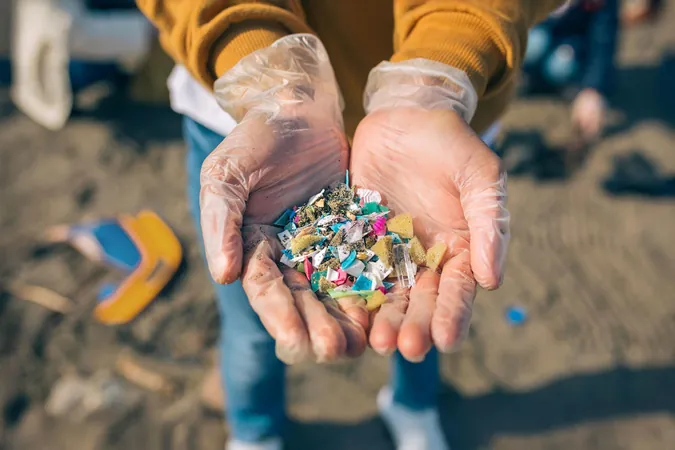
Shocking New Studies Uncover Microplastics' Link to Health Risks and Offer a Promising Cleanup Solution!
2025-01-02
Author: Sarah
Plastic pollution is wreaking havoc on our planet, with many forms of plastic taking decades or even centuries to degrade. As these plastics break down, they create minuscule particles called microplastics, which are less than five millimeters in size. These tiny particles are infiltrating every aspect of our lives—from human blood and breast milk to the food we consume—making their way to even the most remote regions of the Earth.
The presence of microplastics poses two significant challenges: the unknown impact on human health and the difficulty in eliminating them from the environment. Two recent studies shed crucial light on these pressing issues, highlighting the alarming health risks of microplastic exposure, along with a groundbreaking potential solution for mitigating their environmental impact.
Health Risks of Microplastics
The first study, published in the journal TrAC Trends in Analytical Chemistry, analyzed over 900 research articles regarding microplastics and nanoplastics—particles smaller than one micrometer. The findings suggest that these tiny plastic particles tend to accumulate in tissues that exhibit lesions, indicating a potential link to inflammatory diseases, cancer, and other serious health conditions. This raises serious questions about the safety of our food chain and how these microplastics might be contributing to widespread health issues.
Microplastics have been detected across various human tissues and bodily products, including arteries, liver tissue, and even semen. The researchers found a concerning correlation between the concentrations of microplastics and platelet levels in human thrombi, suggesting they could harm the circulatory system. “The alarming link between microplastics and human tissue lesions has sparked urgent scientific inquiry,” the authors stated, emphasizing the need for further investigation into the implications of these findings.
A Promising Cleanup Solution
Meanwhile, a second study highlighted a potential breakthrough in tackling microplastic pollution. Scientists from Wuhan University developed an innovative sponge made from squid chitlin and cellulose obtained from cotton, both of which are recognized for their pollution-absorbing properties. This new sponge aims to provide a biodegradable solution to combat microplastics in our water systems.
The effectiveness of this sponge was tested in different water environments—irrigation, pond, lake, and seawater—where it successfully removed up to 99.9% of microplastics from the samples. “This development is a significant step towards addressing the challenge of microplastic pollution in a scalable manner,” the researchers noted, providing hope that such materials can be used for large-scale cleanup efforts.
Future Directions
Looking ahead, scientists and public health advocates aspire to replace conventional synthetic plastics—often unregulated and harmful—with safer alternatives like bioplastics. However, the transition has faced resistance from industry interests, particularly those tied to fossil fuels. Until effective, regulated alternatives become widespread, the focus will remain on understanding the health implications of microplastics and nanoplastics in our bodies.
Experts remain particularly concerned about whether these particles can pass through the blood-brain barrier, potentially linking them to neurodegenerative diseases such as Alzheimer’s—a possibility that necessitates urgent monitoring and further research.
As we grapple with the staggering impact of microplastics on our planet, researchers are tirelessly searching for ways to restore balance to our ecosystems. The survival of aquatic habitats, vital for biodiversity and human wellbeing, hinges on our ability to address this contamination crisis.
In conclusion, as the situation regarding plastic pollution continues to unfold, it is imperative that both scientists and society take decisive action. The road ahead may be challenging, but the promise of innovative solutions provides hope for a cleaner, healthier world. Stay tuned as we follow these developing stories!



 Brasil (PT)
Brasil (PT)
 Canada (EN)
Canada (EN)
 Chile (ES)
Chile (ES)
 Česko (CS)
Česko (CS)
 대한민국 (KO)
대한민국 (KO)
 España (ES)
España (ES)
 France (FR)
France (FR)
 Hong Kong (EN)
Hong Kong (EN)
 Italia (IT)
Italia (IT)
 日本 (JA)
日本 (JA)
 Magyarország (HU)
Magyarország (HU)
 Norge (NO)
Norge (NO)
 Polska (PL)
Polska (PL)
 Schweiz (DE)
Schweiz (DE)
 Singapore (EN)
Singapore (EN)
 Sverige (SV)
Sverige (SV)
 Suomi (FI)
Suomi (FI)
 Türkiye (TR)
Türkiye (TR)
 الإمارات العربية المتحدة (AR)
الإمارات العربية المتحدة (AR)